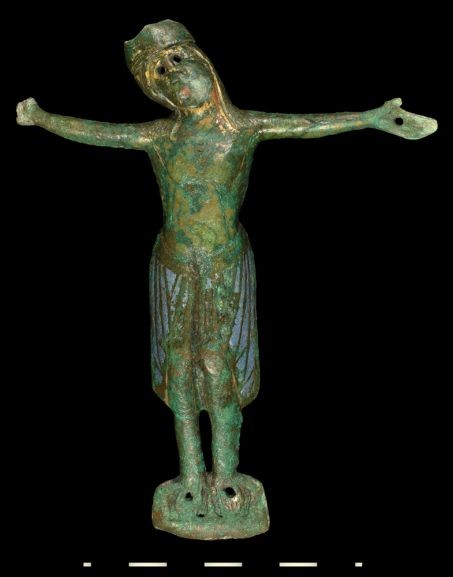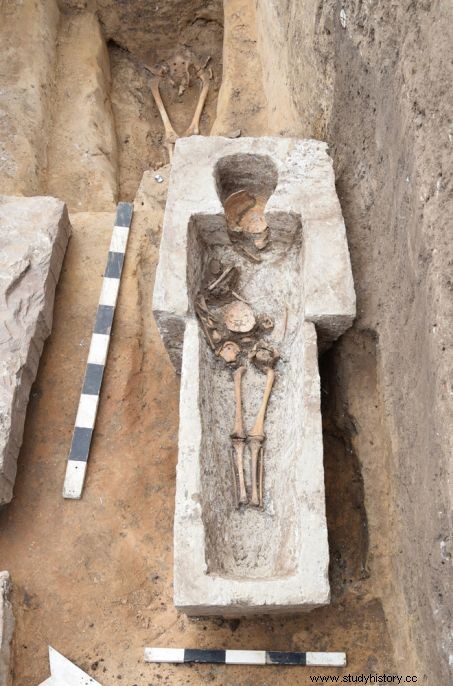The remains of a majestic church and more than 400 tombs have just been unearthed in the Land of Saxony-Anhalt on the site of the former royal palace of Helfta, residence in the 10 th century of the Ottonian dynasty of Eastern Frankish kings, also crowned Roman emperors.

Archaeological excavations at the site of the former Helfta Palace have unearthed more than 400 tombs, including these burials outside the Sainte-Radegonde church.
ARCHAEOLOGY. The German city of Eisleben, in the Land of Saxony-Anhalt, is best known for being the city where Martin Luther (1483-1546), father of the Protestant Reformation, was born and died. This religious movement also took on a dimension of social revolt in the 16th century, which did not spare the Lutheran city; the Peasants' War and the sectarian wars indeed caused the destruction of many buildings, including the 13th century Cistercian monastery of Saint Mary, established in Helfta, at the gates of the city. This was also the case for older constructions, traces of which were found in 2009 during geophysical surveys. An excavation campaign carried out from May to September 2021 has just brought to light imposing remains, which confirm the importance of the site of Helfta towards the end of the High Middle Ages, during the Ottonian period.
The Palace of Helfta, foundation of Otto the Great
The first written traces evoking the site of Helfta date back to Carolingian times, local history mentioning a town called Helpide or Helphidesburg in the register of tithes paid to the imperial abbey of Hersfeld at the end of the 9th century. In the 10th century, the rulers Otto the Great (912-973), king of the Eastern Franks and Roman emperor from 962, and his son Otto II (955-983) would have stayed there at least twice, attesting to the function of the site as the royal palace of the Saxon dynasty of the Ottonians.
Less known than the palaces of Memleben in Thuringia, or Quedlinburg in Saxony-Anhalt, capital of the first Germanic empire, the palace of Helfta is indeed mentioned in the chronicle written between 1012 and 1018 by the famous historian Dhitmar of Merseburg. He reports that Otto the Great was present there in the 960s, when he had Bishop Bernhard of Halberstadt consecrate the church of Helfta to Radegund, Princess of Thuringia, who became Queen of the Franks by marrying King Clotaire. I, and was canonized shortly after his death in 587. According to the same source, Emperor Otto II also stayed in Helfta in 980.
ARCHAEOLOGY. The German city of Eisleben, in the Land of Saxony-Anhalt, is best known for being the city where Martin Luther (1483-1546), father of the Protestant Reformation, was born and died. This religious movement also took on in the 16 th century a dimension of social revolt, which did not spare the Lutheran city; the Peasants' War and the sectarian wars indeed caused the destruction of many buildings, including the Cistercian monastery of the 13 th century of Sainte-Marie, established in Helfta, at the gates of the city. This was also the case for older constructions, traces of which were found in 2009 during geophysical surveys. An excavation campaign carried out from May to September 2021 has just brought to light imposing remains, which confirm the importance of the site of Helfta towards the end of the High Middle Ages, during the Ottonian period.
The Palace of Helfta, foundation of Otto the Great
The first written traces evoking the site of Helfta date back to Carolingian times, local history mentioning a town called Helpide or Helphidesburg in the register of tithes paid to the imperial abbey of Hersfeld at the end of the 9
and
century. At 10
e
century, the sovereigns Otto the Great (912-973), king of the Eastern Franks and Roman emperor from 962, and his son Otto II (955-983) would have stayed there at least twice, attesting to the function of the site in as the royal palace of the Saxon dynasty of the Ottonians.
Less known than the palaces of Memleben in Thuringia, or Quedlinburg in Saxony-Anhalt, capital of the first Germanic empire, the palace of Helfta is indeed mentioned in the chronicle written between 1012 and 1018 by the famous historian Dhitmar of Merseburg. He reports that Otto the Great was present there in the 960s, when he had Bishop Bernhard of Halberstadt consecrate the church of Helfta to Radegund, Princess of Thuringia, who became Queen of the Franks by marrying King Clotaire. I
er
, and was canonized shortly after his death in 587. According to the same source, Emperor Otto II also stayed in Helfta in 980.
The vast palace complex was razed during the Reformation
Very quickly, excavations carried out by archaeologists from the Office for the Preservation of Monuments and Archeology (LDA) of the Land of Saxony-Anhalt managed to find traces of the buildings making up Helfta Palace, razed during the Reform. But as evidenced by geophysical studies of the subsoil, the town of the Carolingian period (8-9 e centuries) and the Ottonian royal court (10 th century) were not directly on the site of the current district of Helfta, east of Eisleben, but on two hills further west. Where the cornfields stretch today, there was then a vast complex of dwellings and fortifications dominating the valley and centered around the hill nicknamed “Kleine Klaus”, on which the majestic Sainte-Radegonde church stood. .
Sainte-Radegonde, a cathedral in miniature
This year's excavation campaign focused on uncovering the remains of this church built by Otto I
st
before 968. From the first weeks, the foundation walls revealed its exceptional nature. For the director of the excavations, Felix Biermann, researcher associated with the LDA of Saxony-Anhalt and professor of archeology of the High Middle Ages at the University of Szczecin (Poland), the magnificence of the building, whose dimensions exceed those of a palatine church, testifies to the rank of this site in Ottonian times. Like a “miniature cathedral ”, the church has three naves and is 30 meters long and about 20 meters wide. Asked by Sciences et Avenir , Felix Biermann underlines the archaeological significance of this discovery:“The church gives us a significant insight into the method of construction and the ground plan of an Ottonian church, without there having been a superstructure. later. It is therefore a very important discovery in terms of the history of architecture. ”
The past splendor of the building can also be guessed in the relics found, such as this figurine of about 15 cm in height representing Christ, whose face is covered with gold and the body with blue enamel. It was probably mounted on a wooden crucifix covered with sheet bronze, which probably served as a processional cross or altar when the Palatine Church evolved into a local pilgrimage church. According to Felix Biermann, there is no doubt that it was made in Limoges in the 13
e
century, “where there were, in the high and late Middle Ages, important artisan workshops for working enamels, whose productions enjoyed great popularity and were widely marketed ”.

Romanesque cross in non-ferrous metal, decorated with enamel, from the church, shortly before the completion of its restoration. © Friederike Hertel / Landesamt für Denkmalpflege und Archäologie Sachsen-Anhalt
The cemetery of the Ottonian elite
The Sainte-Radegonde church was not only a place of worship, it also housed a large number of burials. Archaeologists have unearthed in and around the building more than 400 tombs dating from the 10
th
at 15
th
century, the construction of some of which, very elaborate (niche tombs and brick tombs), indicates that high-ranking dignitaries and noble families of the region were buried there.
The most remarkable in the eyes of Felix Biermann is a small sarcophagus with a niche fitted for the head, made of white shell limestone, carefully worked, and covered with a plate of reddish gray zechstein. It dates back a thousand years and houses a child aged 4 or 5, whose skeleton is completely preserved, apart from the skull. “This tomb which was buried in an important place of the church is particularly impressive ”, confides the archaeologist to us, “because it differs from all the others, and because this child who died too soon was certainly part of an important noble family of the Ottonian period ”. The sarcophagus was recovered as a whole, then transported to the Landesmuseum in Halle, where it will be subjected to scientific analysis before probably being exhibited.
. 
The sarcophagus with niche is a trapezoidal vault with a rounding at the level of the head. ©Normen Posselt / LDA.
A multitude of funerary objects were also found in the tombs:fittings and belt buckles, earrings, coins, knives and other utensils dating from the 8th to the 16 th century, and especially many fibulae in non-ferrous metal, often enamelled and with glass inlays, dating back to the Carolingian and Ottonian periods. As Felix Biermann tells us, these multiple little heavily corroded metal pieces, which could almost go unnoticed, are currently being transformed into “magnificent jewels and richly decorated costume accessories ”, thanks to the restoration work of the LDA workshops.
A nodal point of the Holy Roman Empire
Since its construction at the end of the 10
e
century, the impressive Sainte-Radegonde church dominated the region for 500 years, before being demolished. For archaeologists, its exceptional size, the number of burials and the objects found on the Kleine Klaus hill are the unmistakable sign that Helfta was a site of importance for Otto the Great. The Palatinates were then “ nodal points of the empire ”, explains Felix Biermann, serving as both “bases and temporary residences ”, because the sovereign was constantly on the move within his kingdom and always accompanied by his court. In his various palaces, sometimes only a hundred kilometers away, the sovereign stayed for several weeks or months to exercise his authority:it was there that he dispensed justice, received embassies and celebrated major religious festivals.
Closed at the beginning of September 2021, the archaeological excavations will resume next year with the aim of exploring and unearthing the ramparts and the housing complex. Hoping that future discoveries will better determine the importance of the site for the rulers of the Ottonian dynasty, who reigned over a huge empire extending beyond the present German territories, to Italy.
